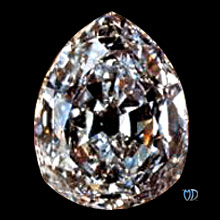The nine largest pieces after the diamond was cut:
Victorian + Edwardian Eras
Wednesday, September 28, 2011
The Cullinan Diamond, or Great Star of Africa
Weighing in at 530.4 carats, the Great Star of Africa, as it is referred to, was discovered in 1905 in Cullinan, a town in northeast South Africa, by miners of the Premier Diamond Mining Company. The stone was named after Sir Thomas Cullinan, owner of the mine. Purchased by the South African government, the diamond was then presented to King Edward VII on his birthday. It was later cut by the Asscher Brothers into several smaller gems.
Else von Freytag-Loringhoven
Born in 1874 when the German Empire was still in existence, Else Hildegard Plotz suffered a difficult childhood in which she was physically and sexually abused by her father. After having practiced prostitution and engaging in several affairs with both genders, she married an architect from Berlin named August Endell in 1901. The following year, Else took up with her husband's friend, Frederick Philip Grove, with August's apparent acquiescence. The trio lived together in Italy, Switzerland, and France before Else followed Grove to a farm in Sparta, Kentucky. Their relationship dissipated shortly after, and, in 1913, Else married the German baron Leopold von Freytag-Loringhoven in New York. Else modeled for artists like Marcel Duchamp and also produced many of her own works, mostly sculpture pieces and paintings, which have been identified as Dadaist. Penniless, Else returned to Berlin 10 years later. Friends found her in a state of near insanity and set her up in a flat in Paris, where she died of gas suffocation in 1927.
One of Else's most famous piece, God:
Memento Mori
So, in addition to jewelry made from hair, Victorians memorialized their loved ones by having daguerrotypes made of them. According to a contributor to Daily Oddities, "This was especially common with infants and young children; Victorian era childhood mortality rates were extremely high, and a post-mortem photograph might be the only image of the child the family ever had. ... The earliest post-mortem photographs are usually close-ups of the face of shots of the full body and rarely include the coffin. The subject is usually depicted so as to seem in a deep sleep, or else arranged to appear more lifelike. Children were often shown in repose on a couch or in a crib," often joined by a favorite toy or family member. Sometimes the subject's eyes were propped open or pupils were painted onto their eyelids. Later European examples popularly featured "the deceased in a coffin with a large group of funeral attendees.
Thursday, April 7, 2011
Aubrey Beardsley
Born in 1872, Aubrey Beardsley was an English illustrator and author who contributed to the Aesthetic and Art Nouveau movements. After completing grammar school, Beardsley worked at an architect's office and insurance company for a time before attending the Westminster School of Art in 1892. He later co-founded The Yellow Book, an influential illustrated quarterly. Many of his illustrations were grotesque and erotic. Though he was a great friend of Oscar Wilde, Beardsley was generally regarded as asexual and was completely devoted to his work. Due to chronic lung hemorrhaging, he was often unable to leave his home. A year before his death, Beardsley converted to Catholicism and begged his publisher to destroy his more obscene drawings, to which Leonard Smithers refused. Beardsley died of tuberculosis in 1898.



Wednesday, February 9, 2011
Folies Bergeres and Ziegfeld Follies
The music hall known as the Folies Bergere was established in 1869 Paris and still operates today. The height of its popularity lasted from the 1890s through the 1920s. It originally opened as an opera house, but switched gears and started catering to popular tastes in 1872. Shows included scantily clad girls and played up Parisian fascination with exoticism and negritude.


Ziegfeld Follies were a series of elaborate theatrical productions on Broadway that ran from 1907 through 1931. Conceived by Florenz Ziegfeld, the Follies were revues inspired by Paris's Folies Bergere. Entertainers like Josephine Baker and and Fanny Brice appeared in the shows. Costumes for the famous Ziegfeld chorus girls were made by such designers as Erte and Lady Duff Gordon.



For more Ziegfeld Follies costume, click here.
Ziegfeld Follies were a series of elaborate theatrical productions on Broadway that ran from 1907 through 1931. Conceived by Florenz Ziegfeld, the Follies were revues inspired by Paris's Folies Bergere. Entertainers like Josephine Baker and and Fanny Brice appeared in the shows. Costumes for the famous Ziegfeld chorus girls were made by such designers as Erte and Lady Duff Gordon.
For more Ziegfeld Follies costume, click here.
Gilded Age Mansion No.1
I plan to do a series of brief posts on various mansions from the Gilded Age in America. This first entry is on the mansion of Payne Whitney, which is now home to the French Cultural Service Offices in New York City. The house, located on 972 Fifth Street, was completed in 1906 as a wedding gift from Whitney's uncle Colonel Oliver Payne. Stanford White began work on the Italian Renaissance palazzo-style house in 1903.

Before Whitney's wife Helen Hay died in 1944, she had her favorite room, the Venetian Room, removed and preserved. In 1987, the mansion was restored and a stained-glass window designed by John La Farge was uncovered. Today, the Payne Whitney House is designated as a New York historical landmark.

The Venetian Room, featured in the movie Rebecca.

The La Farge window.
Read the full story of the Payne Whitney House here.
Before Whitney's wife Helen Hay died in 1944, she had her favorite room, the Venetian Room, removed and preserved. In 1987, the mansion was restored and a stained-glass window designed by John La Farge was uncovered. Today, the Payne Whitney House is designated as a New York historical landmark.
The Venetian Room, featured in the movie Rebecca.
The La Farge window.
Read the full story of the Payne Whitney House here.
Subscribe to:
Posts (Atom)






